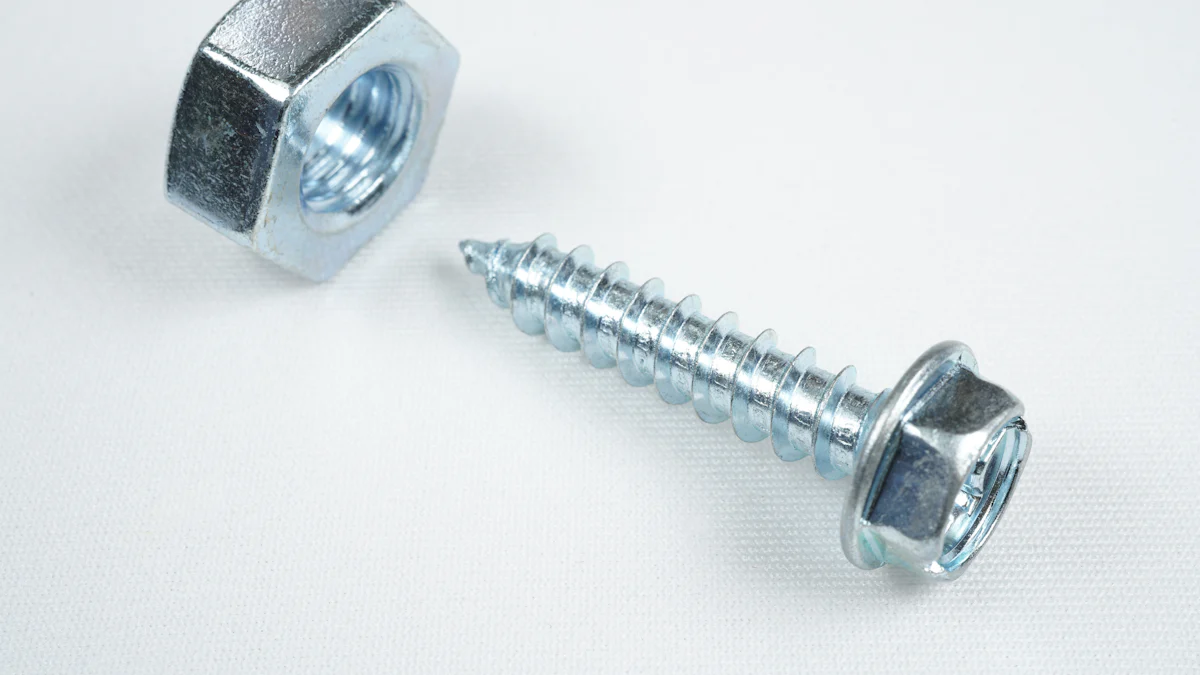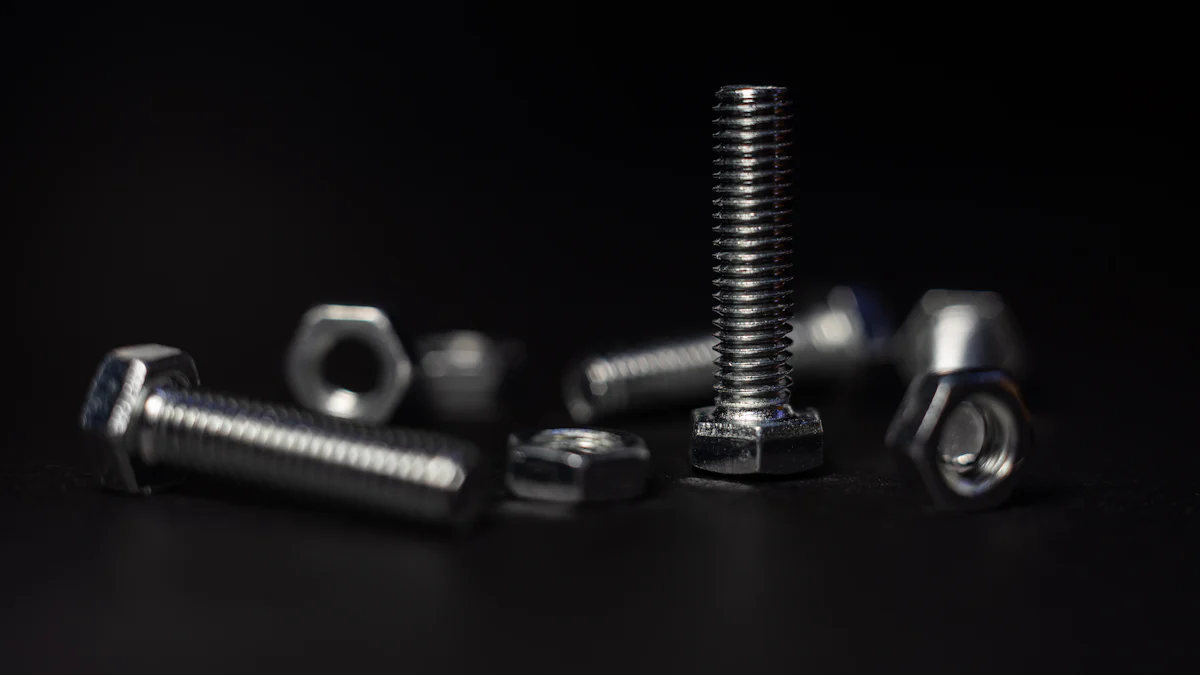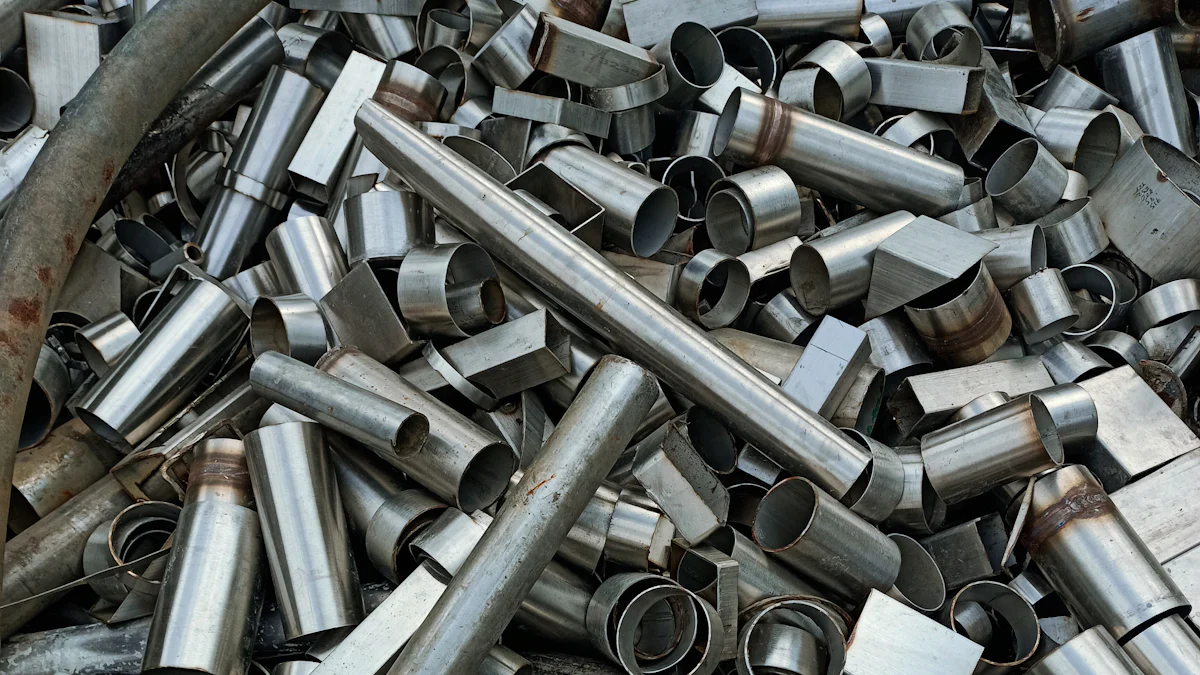
When comparing 17-4 stainless steel vs 304, the choice depends on specific needs. 17-4 stainless steel offers unmatched strength and hardness, making it ideal for demanding applications. On the other hand, 304 stainless steel excels in flexibility and machinability. Factors like corrosion resistance, cost, and application requirements also play a critical role in the selection between 17-4 stainless steel vs 304.
Key Takeaways
- 17-4 stainless steel is great for tough jobs because it is very strong and hard.
- 304 stainless steel resists rust well, so it works for everyday use and wet places.
- To pick one, think about what you need, where it will be used, and how much you can spend.
Chemical Composition
Composition of 17-4 Stainless Steel
When I examine 17-4 stainless steel, its unique chemical makeup stands out. This alloy contains approximately 15-17.5% chromium, which provides a solid foundation for corrosion resistance. Nickel, ranging from 3-5%, enhances its toughness. Copper, present in similar amounts, plays a critical role in boosting its mechanical strength. Additionally, small amounts of niobium and tantalum (0.15-0.45%) contribute to its excellent hardness and durability. Other elements like carbon, manganese, silicon, phosphorus, and sulfur are present in minimal quantities to fine-tune its properties. The balance of the composition is iron, which forms the primary structure of the alloy.
| Element | Percentage Range (%) |
|---|---|
| Chromium | 15.0 – 17.5 |
| Nickel | 3.0 – 5.0 |
| Copper | 3.0 – 5.0 |
| Niobium + Tantalum | 0.15 – 0.45 |
| Carbon | 0.07 max |
| Manganese | 1.0 max |
| Silicon | 1.0 max |
| Phosphorus | 0.04 max |
| Sulfur | 0.03 max |
| Iron | Balance |
Composition of 304 Stainless Steel
304 stainless steel, on the other hand, features a simpler yet highly effective composition. It contains over 18% chromium, which significantly enhances its corrosion resistance. Nickel, ranging from 8-10%, further improves its ability to withstand harsh environments. Unlike 17-4, 304 lacks copper, niobium, or tantalum. This absence makes it less specialized but more versatile for general applications. The remaining elements include trace amounts of carbon, manganese, silicon, phosphorus, and sulfur, with iron making up the majority.
| Element | 17-4 Stainless Steel | 304 Stainless Steel |
|---|---|---|
| Chromium | ~15% | Higher than 18% |
| Nickel | 4% | ~8-10% |
| Copper | Present | Absent |
Impact of Composition on Properties
The chemical differences between these two grades directly influence their performance. The copper and niobium in 17-4 stainless steel give it high strength and excellent mechanical properties, making it ideal for demanding applications. In contrast, the higher chromium and nickel content in 304 stainless steel enhances its corrosion resistance, making it suitable for environments exposed to moisture or chemicals. These distinctions highlight why choosing between 17-4 stainless steel vs 304 depends on the specific requirements of the application.
Mechanical Properties
Strength and Hardness
When comparing the strength and hardness of 17-4 stainless steel and 304 stainless steel, the differences are significant. 17-4 stainless steel exhibits exceptional tensile strength, ranging from 910 to 1390 MPa, and yield strength between 580 and 1250 MPa. Its hardness, measured at 280 to 440 BHN, makes it ideal for applications requiring durability and wear resistance. In contrast, 304 stainless steel offers tensile strength between 580 and 1180 MPa and yield strength from 230 to 860 MPa. While 304 lacks a specific hardness rating, its softer nature makes it more suitable for general-purpose applications.
| Property | 17-4 Stainless Steel | 304 Stainless Steel |
|---|---|---|
| Tensile Strength | 910 to 1390 MPa | 580 to 1180 MPa |
| Yield Strength | 580 to 1250 MPa | 230 to 860 MPa |
| Hardness | 280 to 440 BHN | N/A |
Ductility and Toughness
The ductility of 304 stainless steel surpasses that of 17-4 stainless steel. With an elongation at break of up to 43%, 304 is highly formable and resists cracking during shaping. On the other hand, 17-4 stainless steel offers moderate ductility, with elongation ranging from 11% to 21%. Despite this, 17-4 excels in toughness, making it suitable for applications involving impact or shock loading. While 304 is also tough, it cannot match the impact resistance of 17-4 in demanding environments.
- 17-4 stainless steel: Moderate ductility (11%-21%), excellent toughness.
- 304 stainless steel: High ductility (up to 43%), good toughness but less impact-resistant.
Performance at High Temperatures
The performance of these two grades diverges significantly at elevated temperatures. 304 stainless steel withstands temperatures up to 925°C, making it suitable for high-heat environments. In contrast, 17-4 stainless steel performs optimally up to 600°F (316°C). However, 17-4 offers better resistance to stress corrosion cracking, making it advantageous in aerospace and chemical processing applications. For general use, 304 remains the preferred choice due to its broader temperature range.
| Property | 17-4 PH Stainless Steel | 304 Stainless Steel |
|---|---|---|
| Maximum Temperature | 600°F (316°C) | 925°C |
| Corrosion Resistance | Better | Less effective |
| Stress Corrosion Cracking | More resistant | Less resistant |
| Ideal Applications | Aerospace, Chemical Processing | General use |
Corrosion Resistance

General Corrosion Resistance
When I compare the general corrosion resistance of 17-4 stainless steel and 304 stainless steel, the differences become clear. 304 stainless steel excels in a wide range of environments due to its high chromium and nickel content. It resists corrosion effectively, even in moist or chemically aggressive conditions. In contrast, 17-4 stainless steel offers good corrosion resistance but performs best at temperatures up to 600°F (316°C). Its strength and hardness make it ideal for high-stress applications, but it cannot match the versatility of 304 in environments prone to corrosion.
| Property | 17-4 PH Stainless Steel | 304 Stainless Steel |
|---|---|---|
| Corrosion Resistance | Good up to 600°F (316°C) | Excellent in various environments |
| Pitting and Crevice Corrosion | More resistant to chloride-induced stress corrosion | Prone to pitting in warm chloride environments |
| High-Temperature Performance | Superior at high temperatures | Performance drops at higher temperatures |
| Application Suitability | Best for high-stress, high-temperature environments | Versatile and easy to fabricate |
Resistance to Chloride Stress Corrosion Cracking
Chloride stress corrosion cracking poses a significant challenge in many industrial applications. I find that 17-4 stainless steel outperforms 304 stainless steel in this regard. Its composition provides superior resistance to chloride-induced stress corrosion cracking, making it a better choice for environments where chloride exposure is a concern. While 304 stainless steel offers excellent general corrosion resistance, it is more prone to cracking under chloride stress. This distinction makes 17-4 stainless steel the preferred option for applications in chemical processing or marine industries where chloride exposure is unavoidable.
- 17-4 stainless steel offers superior resistance to chloride-induced stress corrosion cracking compared to 304 stainless steel.
- 17-4 PH stainless steel exhibits greater resistance to chloride-induced stress corrosion cracking than 304 stainless steel.
- 17-4 stainless steel is better suited for environments prone to chloride stress corrosion cracking compared to 304 stainless steel.
Suitability for Marine Environments
Marine environments demand materials with exceptional corrosion resistance. In my experience, 304 stainless steel is the better choice for these conditions. Its ability to resist pitting and crevice corrosion makes it highly effective in saltwater and other marine settings. On the other hand, 17-4 stainless steel, while strong and durable, is more vulnerable to these types of corrosion. This vulnerability limits its suitability for marine applications. For projects involving prolonged exposure to seawater or humid coastal environments, I recommend 304 stainless steel as the more reliable option.
Machinability and Weldability
Machinability of 17-4 Stainless Steel
I find machining 17-4 stainless steel challenging due to its high strength and hardness. These properties often lead to increased tool wear and require specialized cutting tools. Heat treatment can improve its machinability, but even then, it remains more difficult to machine than 304 stainless steel. Operators must use slower cutting speeds and apply proper lubrication to achieve precise results. This alloy’s precipitation-hardening nature adds complexity, making it less suitable for projects requiring extensive machining.
Machinability of 304 Stainless Steel
In contrast, 304 stainless steel offers excellent machinability, especially in its annealed state. Its softer composition allows for faster cutting speeds and reduces tool wear, making it a preferred choice for machining-intensive applications. I find that 304 stainless steel is easier to shape and drill, which enhances its versatility. This grade performs well with standard machining equipment, eliminating the need for specialized tools or techniques. Its superior machinability makes it ideal for industries requiring high production efficiency.
Welding Considerations for Both Grades
Welding 17-4 stainless steel presents unique challenges. Preheating is necessary to minimize the risk of cracking, and post-weld heat treatment is required to restore its mechanical properties. These additional steps increase the complexity and cost of welding this alloy. On the other hand, 304 stainless steel is much easier to weld. It does not require preheating or post-weld treatment, and common welding techniques work effectively. This simplicity makes 304 stainless steel a more practical option for projects involving extensive welding.
| Property | 17-4 Stainless Steel | 304 Stainless Steel |
|---|---|---|
| Pre-Weld Treatment | Requires preheating to reduce cracking risks | No special pre-weld treatment needed |
| Post-Weld Treatment | Requires heat treatment to restore properties | No special post-weld treatment needed |
| Ease of Welding | More challenging due to precipitation-hardening properties | Easier to weld with common techniques |
When comparing 17-4 stainless steel vs 304, the latter stands out for its ease of machining and welding. These advantages make 304 stainless steel a more cost-effective and versatile choice for many applications.
Cost and Availability
Price Differences
When I compare the costs of 17-4 stainless steel and 304 stainless steel, the difference is clear. 17-4 stainless steel typically costs more due to its complex manufacturing process and the inclusion of specialized alloying elements like copper and niobium. Its heat treatment requirements further add to the production expenses. On the other hand, 304 stainless steel is more affordable. Its simpler composition and widespread production make it a cost-effective choice for many industries. For projects with tight budgets, 304 stainless steel often becomes the preferred option.
Market Availability
The availability of these two grades also varies significantly. 304 stainless steel is one of the most commonly used stainless steel grades. Its broad application across industries ensures a steady supply in various forms and sizes. In contrast, 17-4 stainless steel is less widely available. Its specialized production process and niche demand make sourcing more challenging. This limited availability can lead to higher costs and longer lead times for procurement. For applications requiring quick turnaround times, 304 stainless steel offers a clear advantage.
- 304 stainless steel is widely available due to its broad industrial use.
- 17-4 stainless steel has lower availability because of its specialized production and niche demand.
Cost-Effectiveness for Applications
The cost-effectiveness of these materials depends on the application. 304 stainless steel is easier to manufacture and more economical, making it suitable for general-purpose use. Its affordability and availability enhance its value for projects requiring large quantities. However, 17-4 stainless steel provides superior strength and durability, which justifies its higher cost in high-stress applications. For industries like aerospace or chemical processing, where performance outweighs cost, 17-4 stainless steel becomes the better investment.
- 304 stainless steel is ideal for cost-sensitive and general-purpose applications.
- 17-4 stainless steel excels in high-stress environments despite its higher cost.
Applications

Common Uses of 17-4 Stainless Steel
I often recommend 17-4 stainless steel for industries requiring high strength and durability. Its unique properties make it indispensable in several demanding applications:
- Aerospace Components: This alloy is ideal for turbine blades, fasteners, and structural parts due to its strength and resistance to stress.
- Marine Applications: Offshore platforms rely on it for valves and pumps that endure harsh saltwater environments.
- Oil & Gas Industry: Valve stems, pump shafts, and fittings benefit from its excellent mechanical performance.
- Medical Devices: Surgical tools and orthopedic implants utilize this material for its biocompatibility and toughness.
- Nuclear Industry: Power plants use it for components requiring radiation resistance and strength.
- Defense Equipment: Gun parts and military-grade fasteners depend on its reliability under extreme conditions.
Common Uses of 304 Stainless Steel
304 stainless steel stands out for its versatility and corrosion resistance. I often see it used across a wide range of industries:
| Industry | Application Description |
|---|---|
| Chemical Processing | Ideal for chemical containers, tanks, and equipment due to its resilience against corrosive substances. |
| Food and Beverage | Used in food processing equipment and storage tanks for its hygienic properties and resistance to contamination. |
| Medical and Pharmaceutical | Commonly used in medical devices and surgical instruments for its corrosion resistance and ease of sterilization. |
| Architectural Design | Chosen for panels and railings due to its aesthetic appeal and durability. |
| Automotive | Utilized in trim and exhaust systems for its durability and heat resistance. |
| Household Products | Found in kitchenware like pots and pans for its corrosion resistance and ease of cleaning. |
Selecting the Right Grade for Your Application
When deciding between 17-4 stainless steel and 304 stainless steel, I always consider the specific demands of the application. For high-stress environments, such as aerospace or defense, 17-4 stainless steel offers unmatched strength and toughness. However, for general-purpose use, especially in environments prone to corrosion, 304 stainless steel provides superior versatility and cost-effectiveness. If your project involves marine or food-grade applications, 304 stainless steel is the better choice. On the other hand, industries like oil and gas or nuclear power benefit from the durability and performance of 17-4 stainless steel.
Ultimately, the decision between 17-4 stainless steel vs 304 depends on balancing mechanical requirements, environmental exposure, and budget constraints.
Choosing between 17-4 stainless steel and 304 stainless steel depends on application needs. 17-4 stainless steel excels in strength, hardness, and tailored mechanical properties, making it ideal for high-stress environments. Meanwhile, 304 stainless steel offers superior corrosion resistance and versatility, perfect for general-purpose use. Balancing mechanical demands, environmental exposure, and budget ensures the right choice.
FAQ
What are the main differences between 17-4 stainless steel and 304 stainless steel?
Key Differences
- Strength: 17-4 offers higher strength and hardness.
- Corrosion Resistance: 304 excels in general corrosion resistance.
- Applications: 17-4 suits high-stress uses; 304 fits general-purpose needs.
Can 17-4 stainless steel replace 304 stainless steel in marine environments?
No, I wouldn’t recommend it. 304 stainless steel performs better in marine settings due to its superior resistance to pitting and crevice corrosion caused by saltwater exposure.
Which grade is more cost-effective for large-scale projects?
304 stainless steel is more cost-effective. Its affordability, ease of machining, and wide availability make it ideal for large-scale applications requiring significant material quantities.
